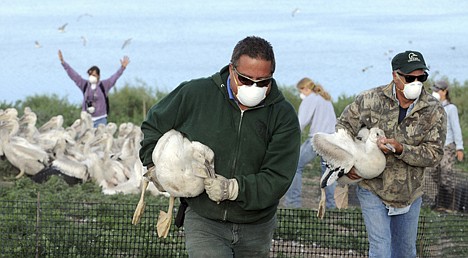Idaho enlists skunks, badgers to control pelicans
John Miller | Hagadone News Network | UPDATED 15 years, 8 months AGO
BOISE - It's badger and skunk versus pelican in the latest round of Idaho wildlife managers' fight to control these big birds that they blame for eating too many fish.
The state Department of Fish and Game have released three badgers and two skunks on the Blackfoot Reservoir's Gull Island to reduce the number of the migratory birds that successfully nest there this year. But setting free predators to pursue pelicans drew criticism Wednesday from an Idaho State University scientist who said there's insufficient data to show pelicans alone are responsible for trout declines.
The American white pelican, whose numbers have tripled in Idaho in recent years, is being targeted for eating sensitive Yellowstone cutthroat trout, as well as stocked rainbow trout coveted by anglers.
In 2009, U.S. Fish and Wildlife Service officials panned Idaho Fish and Game's proposal to shoot pelicans and oil their eggs, calling it an "eradication program." Federal approval would have been required for any lethal pelican control.
As a result, state managers are now doing what they can without that approval - by letting the skunks and badgers do their part.
"The growth of this nesting colony is so great that our data clearly demonstrates a clear and present threat to the viability and sustainability of the Yellowstone cutthroat trout stocks in the Blackfoot Reservoir," said Mark Gamblin, Fish and Game's regional supervisor for southeastern Idaho.
Gamblin's agency in 2009 had considered, then discarded, the idea of releasing predators on concerns of impacts on other nesting birds like geese or Caspian terns. For instance, badgers were removed from Gull Island in the 1990s - to improve habitat for nesting Canada geese.
But if the federal government won't let Idaho shoot pelicans and oil eggs, Gamblin said, "our only option right now is to take actions to arrest the growth."
Pelicans in two colonies in southeastern Idaho, one on the Blackfoot Reservoir and the other on the Snake River's Lake Walcott, have tripled to about 7,000 birds since 2002. The 2010 numbers won't be available until this summer.
Idaho wants to reduce their numbers to 700 birds at the Blackfoot Reservoir and 2,100 at Lake Walcott by 2013.
Brad Bortner, who heads the federal agency's migratory birds programs in Portland, Ore., confirmed that setting badgers and skunks free, as long as it was meant to keep them from nesting successfully, wouldn't violate the Migratory Bird Treaty Act of 1918.
"We did not authorize them to take pelican eggs or their young," Bortner said Wednesday, while conceding that's a possibility. "We all understand that the consequence of that kind of management could result in that."
David Delehanty, an Idaho State University biology professor, works with the Department of Fish and Game and supports appropriate research on animals. Still, he thinks using skunks and badgers for pelican control is inappropriate, in part because it could expose the predators to starvation without a long-term food supply on the island.
And while sport anglers are pressuring Fish and Game to intervene to reduce pelican numbers, Delehanty hasn't seen evidence to convince him that the birds are significantly denting populations of stocked rainbow trout - or the native Yellowstone cutthroats.
Irrigation drawdowns, reservoir temperature, competition from nonnative fish and selenium contamination from phosphate mines upstream must also be considered when addressing the fish's plight, he said.
"There are a lot of reasons to think that Yellowstone cutthroat trout have collapsed that have nothing to do with American white pelicans," Delehanty said. "It needs to be studied. Otherwise, we're just arguing."
ARTICLES BY JOHN MILLER
Governor wins with exchange, tax repeal plan
BOISE (AP) — After the 2013 session ended, Gov. C.L. “Butch” Otter joked that he grew confident his proposal for a state-based health insurance exchange would succeed only “when that bill hit my desk.”
Idaho lawmakers adjourn, settle education budget
BOISE (AP) — The 2013 Idaho Legislature adjourned Thursday, nearly a week later than expected, after lawmakers finally completed the $1.3 billion education budget.
Idaho House panel backs state insurance exchange
BOISE (AP) — The House Health and Welfare Committee backed a state-based, nonprofit insurance exchange Thursday, conceding that it wasn’t a perfect solution, but it was better than merely accepting a version run from Washington, D.C.

